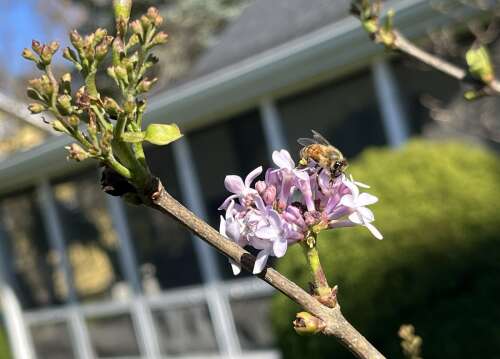You know it’s May when that first heady scent of lilac wafts through the air.
But it’s not May. It’s November. And across the suburbs, some plants that typically bloom in the spring, like lilacs, are flaunting their petals.
Is this odd?
“Yes and no,” Morton Arboretum Arboretum Plant Knowledge Specialist Sharon Yiesla said Tuesday.
“Every year, there are certain plants that will put out a few flowers late in the season,” such as magnolia trees and viburnums. “So in that respect, it’s kind of normal.
“But what we’re seeing now is often heavy flowering,” Yiesla added. “We’ve had reports from people that their lilacs are in full flower and similar reports about crabapple trees and serviceberries, so it’s much more widespread this year in a lot of different types of plants.”
Yiesla explained, “the weather certainly is playing a role because our weather has been very up and down this year. First we get a hot spell, then it got cool and then a hot spell.”
The Chicago Botanic Garden’s Jacob Burns said spring stars like lilacs and forsythias “can be tricked into reblooming in the fall and that is basically attributed to the weather extremes and the stresses that are put on the plant.
“We had a major drought this summer that probably tricked these plants into going into an early dormancy. They probably thought ‘oh it’s time to go to sleep now.’ And then all of a sudden, this mild fall, and more wet weather and the shorter days mimicked spring and tricked some of these flower buds into opening up.”
It’s mostly woody plants flowering, as other spring staples like tulips and daffodils are dormant underground, away from the elements, said Burns, the CBG’s curator, plant collections operations.
National Weather Service meteorologist Ricky Castro noted “it’s been persistently warm this fall.”
Through Monday, temperatures have averaged 8.3 degrees above normal this month, based on data from the DuPage Airport, Castro said. October averaged 4.6 degrees above normal.
And since Oct. 1, there’s only been four nights when temperatures were freezing or lower. Nov. 2 was the last time temperatures were in the 20s, Castro added.
“If it drops into the 20s at night, it will be hard to sustain plant growth,” he said.
Plant growth habits are “tied into hormones and they react often to changes in the environment,” Yiesla explained.
“If a certain hormone is out of balance, we may see flowering at the wrong time.”
A rose that’s typically done for the year by November blooms in DuPage County on Tuesday.
Marni Pyke/[email protected]
What gardeners can do
Experts recommend watering thoroughly during droughts to prevent early dormancy.
For species that are still flowering, “know that this plant is actively growing,” Yiesla said. “Probably the most important thing people could do for their plants right now would be to water, so the plants have enough water to complete whatever process they’re doing right now. Water is also important for the production of buds.”
Burns advised gardeners not to fret about early bloomers. “You’ll probably have noticed a lot of buds that haven’t opened. You should still see spring flowers” although there could be fewer, he said.
“It was a rough year for plants, we had our ups and down,” Burns added. “I feel like every time I’ve driven past a home that has your common lilac in it — I’ve seen flowers on it. It’s really weird to see that but it’s not any cause for concern. Not yet anyway.”
Do you have unexpected blooms on your plants? Send a photo to [email protected].
